The Thief of Bagdad (1924)
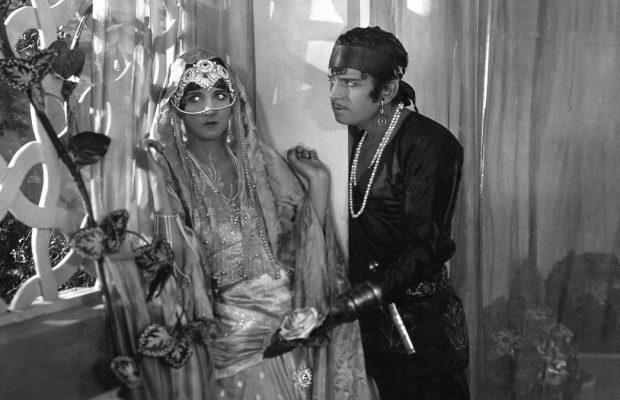
Toronto Film Society presented The Thief of Bagdad (1924) on Sunday, February 5, 2023 as part of the Season 75 Sunday Afternoon Film Buffs Series, Programme 5.
Produced by: Fairbanks-United Artists. Directed by: Raoul Walsh. Story by: Elton Thomas (pseudonym for Douglas Fairbanks and Kenneth Davenport). Scenario by: Lotta Woods. Settings by: William Cameron Menzies. Photography by: Arthur Edeson.
Cast: Douglas Fairbanks (The Thief), Julanne Johnston (The Princess) Edwards Snitz (The Thief’s Evil Associate), Brandon Hurst (The Caliph), Anna May Wong (The Mongol Slave), Etta Lee (The Slave of the Lute).
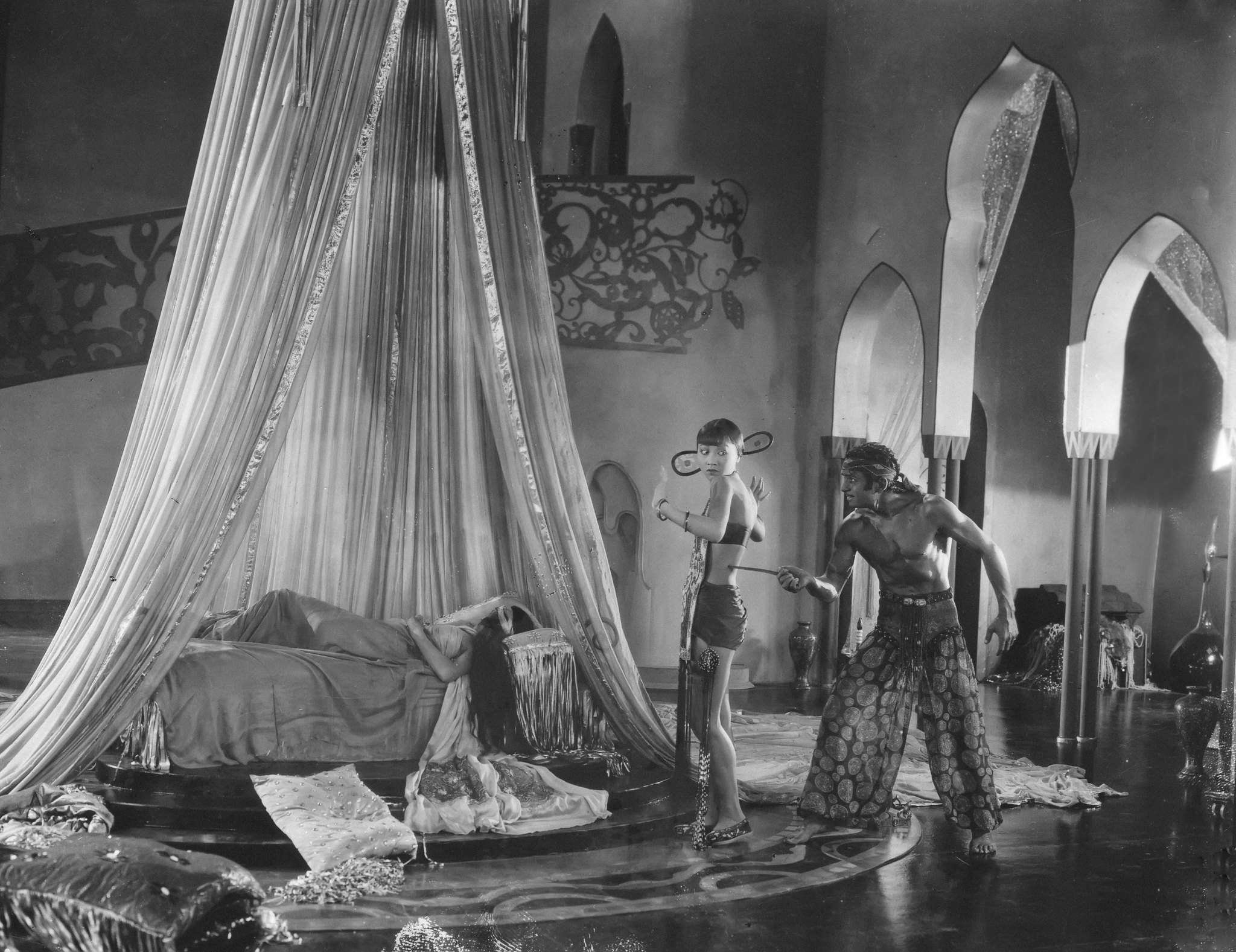
The following pertinent extract from Chapter 16 of Douglas Fairbanks: The Fourth Musketeer, by Ralph Hancock and Letitia Fairbanks, may be of interest:
Douglas planned to follow Robin Hood with a pirate story and the search, scenario, set and costume designs, and production plans were complete and ready to begin shooting when he popped into a staff meeting one day and exclaimed, “Let’s do an Arabian Nights story instead!”
For several weeks after the switch, the place fairly hummed – with Arabian undertones – and when several tons of collateral reading had been consumed, digested, and summarized, Doug began looking for a gimmick on which to hang the story. Since he did none of the reading and only glanced at the summaries, one wonders how he managed to absorb enough “atmosphere” to make any decision, but Doug could surround himself with ten experts on the same subject and absorb, seemingly by mental telepathy, enough knowledge to make him sound like an authority.
He found his theme in a quatrain from Sir Richard Francis Burton’s translations:
Seek not they happiness to steal
‘Tis work alone will bring thee weal
Who seeketh bliss without toil or strife
The impossible seeketh and wasteth life.
Which he condensed to “happiness must be earned”. On this bare dictum, he built the story that took eight months to photograph and fifteen reels to tell. When the scenario was worked out to the last detail, it looked like a formidable undertaking. “If we don’t find some way to defeat that thing,” said Doug, pointing to the enormous manuscript, “it will defeat us by its sheer magnitude.”
The production staff finally had to make blueprint charts on which each set and sequence was listed and with these mounted on the walls of the offices, they were able to visualize the whole production and its day-to-day progress.
The finished picture was a symphony in fantasy, its texture woven of the slender thread of dreams. Its people moved in a fairyland where everything rested upon the light and airy foundation of fancy. This was the spirit of The Thief of Bagdad, and to translate it into a motion picture was a thing that conscripted all the artistic, mechanical, and imaginative talents of many people and into it went the heart and ambition of scores of artists.
First of all, there was the basic fact that when a thing is photographed, it is given substance and reality. This was purposely overcome by gleaming highlights along the base lines, destroying the reality of solid foundations. The magnificent structures, with their shadows growing darker as they ascended, seemed to have the fantastic quality of hanging from the clouds rather than being firmly set upon the earth.
To further the illusion, the environment of the characters was designed out of proportion to human fact. Flowers, vases, stairs, windows, and decorative effects were given a bizarre quality suggestive of the unreal.
William Cameron Menzies designed the sets and on paper, they had the quality of fairyland Douglas was looking for, but when built they proved too solid and substantial-looking. After seeing several test shots Doug said, “Those things are anchored to earth. There’s nothing ephemeral about them and we’ve got to find a way to lift them up.”
Inconceivable as it might seem, four acres of cement was the answer. This, covered with several coats of black paint and polished to a high gloss, constituted the central plaza around which was constructed the city of Bagdad – walls, minarets, domes, stairways, bazaars and all. The end effect, with all this gaudy architecture reflected in the polished cement, was a city not quite of the earth nor yet of heaven but some sort of dreamland in between.
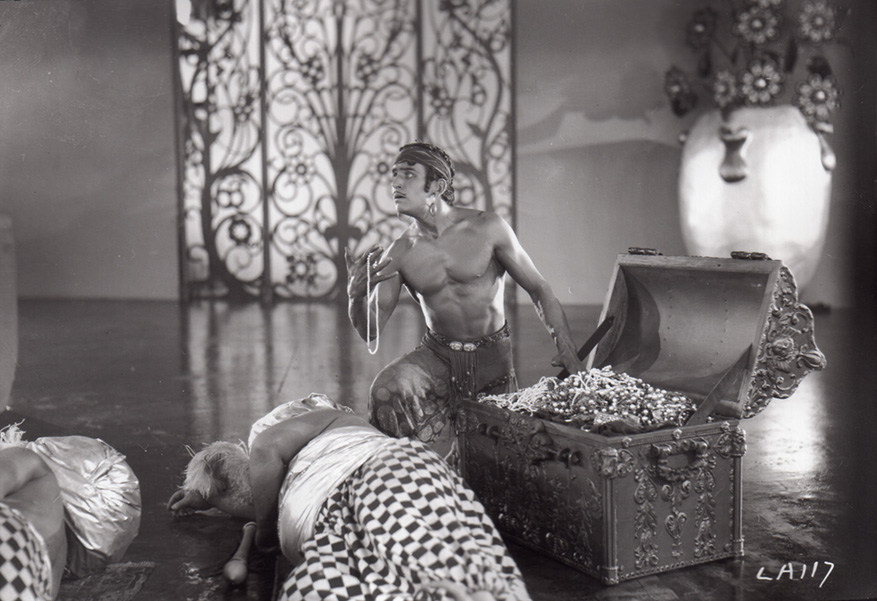
Raoul Walsh was the director and he recruited most of his mob extras from the local dives. He got plenty of color and contrast that way, but he also had his troubles handling them. He broke up more than one fight with his own fists. Another hazard he had less success with was that he was extremely attractive to women and whenever Doug wanted to find his director, he looked over the lot and picked out the largest group of feminine fans. In its centre would be Walsh.
It could be said of The Thief of Bagdad what Pierre Berton once said in admiration of Disneyland: that somebody had obviously declared, “I don’t care how much it costs, but let’s do the thing properly!” No expense was spared to make the film an embodiment of all that we imagine whenever we read the Arabian Nights tales (especially from a lavishly illustrated edition). The unprecedented two million dollars that it cost (in those days, before inflation) were channeled toward “doing the thing properly”, not into displaying a two-million-dollar “epic” in which “every dollar shows”. Viewing it today, one’s only possible regret is that it was made before the introduction of colour photography.
But in spite of the high praise from all the critics, and of the enthusiasm of small boys everywhere (especially this one), The Thief of Bagdad was considerably less popular at the box-office than his previous opus, Robin Hood, which had cost only $700,000. (Indeed, no other picture Doug ever made, before or afterwards, surpassed Robin Hood in popularity). Possibly the adult American population, in those feverish, cynical 1920’s, was little attracted to fantasy (it seldom is at any time). Possibly, too, the vogue for Orientalism, which had been so strongly influential in the years just before and during the War (Omar Khayyam…Scheherezade…Chu Chin Chow…and reflected, as late as 1922, in Doña Sol’s apartments in Blood and Sand), had already begun to wane. At any rate, Fairbanks took the hint and never again produced anything so extravagantly elaborate. But we doubt if he ever regretted it.
Incidentally, the Bagdad domes and minarets built for the film remained standing on the Fairbanks lot for many years afterwards, visible for miles around.
P.S. We’ll let you in on another secret: the “M. Comant” who played the Persian Prince was actually a woman.
The Triangle company had just recently been formed by the banding together of the production companies of D.W. Griffith, Mack Sennett and Thomas Ince. Fairbanks’ first film for them was The Lamb, an adaptation of his stage success, The New Henrietta.
The ebullient, irresponsible Fairbanks, whose excess energies were perpetually spilling over into almost unceasing athletic displays on camera as well as off, did not appeal to Griffith, who was supervising the production of The Lamb; Griffith seriously felt that Fairbanks would do much better under Sennett, a suggestion that didn’t appeal to Fairbanks, who considered he was demeaning himself sufficiently by appearing in pictures at all. Fortunately, some shrewd person or persons saw to it that he got together with two other Triangle employees: scenario writer Anita Loos (writer of The New York Hat and future author of the novel Gentlemen Prefer Blondes) and director John Emerson, who soon saw how the exuberant Fairbanks off-stage personality could be exploited on the screen.
Much to everyone’s surprise, The Lamb proved a hit, and Fairbanks was turned over to the Loos-Emerson team, which produced 12 films in as many months, to the end of 1916. So popular were these films that by that time Fairbanks was drawing a salary of $10,000 a week. But even this wasn’t enough for him, so instead of renewing his contract with Triangle, he and his brother formed the Douglas Fairbanks Corporation to make his own films and thus keep all the profits himself.
The films were released by Famous Players-Lasky under their Artcraft label. From Triangle he brought his collaborators, John Emerson and Anita Loos, and (working at a slower pace) they turned out another 12 pictures over the next two years. In 1919, Fairbanks, Pickford, Griffith, and Chaplin (“the Big Four”) formed their own distributing company, United Artists Corporation, which handled all their films thereafter.
In the five years from his entry into films till the summer of 1920, Fairbanks made 29 films (most of them, though not all, written by Anita Loos and directed by John Emerson) which were, in in general, simply variations on a single theme: the brash, enthusiastic young “100% American”, brimming over with vigor and optimism and know-how,“Mr. Average Man with the powers of Superman” triumphing over all obstacles. So suitable was this formula to his personality, and vice versa, and to the times, that by 1920 he was one of the most loved stars of the screen, not simply in America but all over the world. In March of that year, he married the screen’s most popular actress, Mary Pickford, a romance enthusiastically endorsed by the delighted public, (who didn’t seem in the least to mind that both had had to divorce their current mates to make it possible). Their honeymoon in Europe was like a Royal Tour.
Then, in the summer of 1920, Doug suddenly took a big chance and tried a new type of film: a costume romance, The Mark of ,Zorro. So unsure was he of its reception by the public that when it was finished but before it was released, he hurriedly made the 30th film in the tried-and-true formula, The Nut. But The Mark of Zorro proved to be far and away his most popular film to date, and so for the rest of the silent era, Fairbanks produced nothing but big costume pictures, at the rate of no more and frequently fewer than one a year. The last was The Iron Mask (1929), in which he said farewell to the screen character the public had loved. He was by now 46 years old.
For years. the fans had been clamouring for Doug and Mary to make a picture together; but when they finally did, The Taming of the Shrew proved not to be the picture the public wanted. His few remaining films were received with similar apathy (and made, it is reported, with similar lack of enthusiasm on his part). In 1934 he made a film for Alexander Korda, The Private Life of Don Juan, and then no more.
All his life Douglas Fairbanks had worshipped youth, and with the passing of his own, a pitiful demoralization set in. His frantic restlessness wrecked his marriage with Mary Pickford, a blow to their fans from which neither recovered, and in 1936 he married Lady Sylvia Ashley. Although making no more films, he continued to lead a strenuously active life in Hollywood, in spite of warning signals, and eventually a coronary thrombosis ended his life on December 12, 1939, at the age of 56.
Notes by Fraser Macdonald, written for our November 13, 1964 screening, Season 16
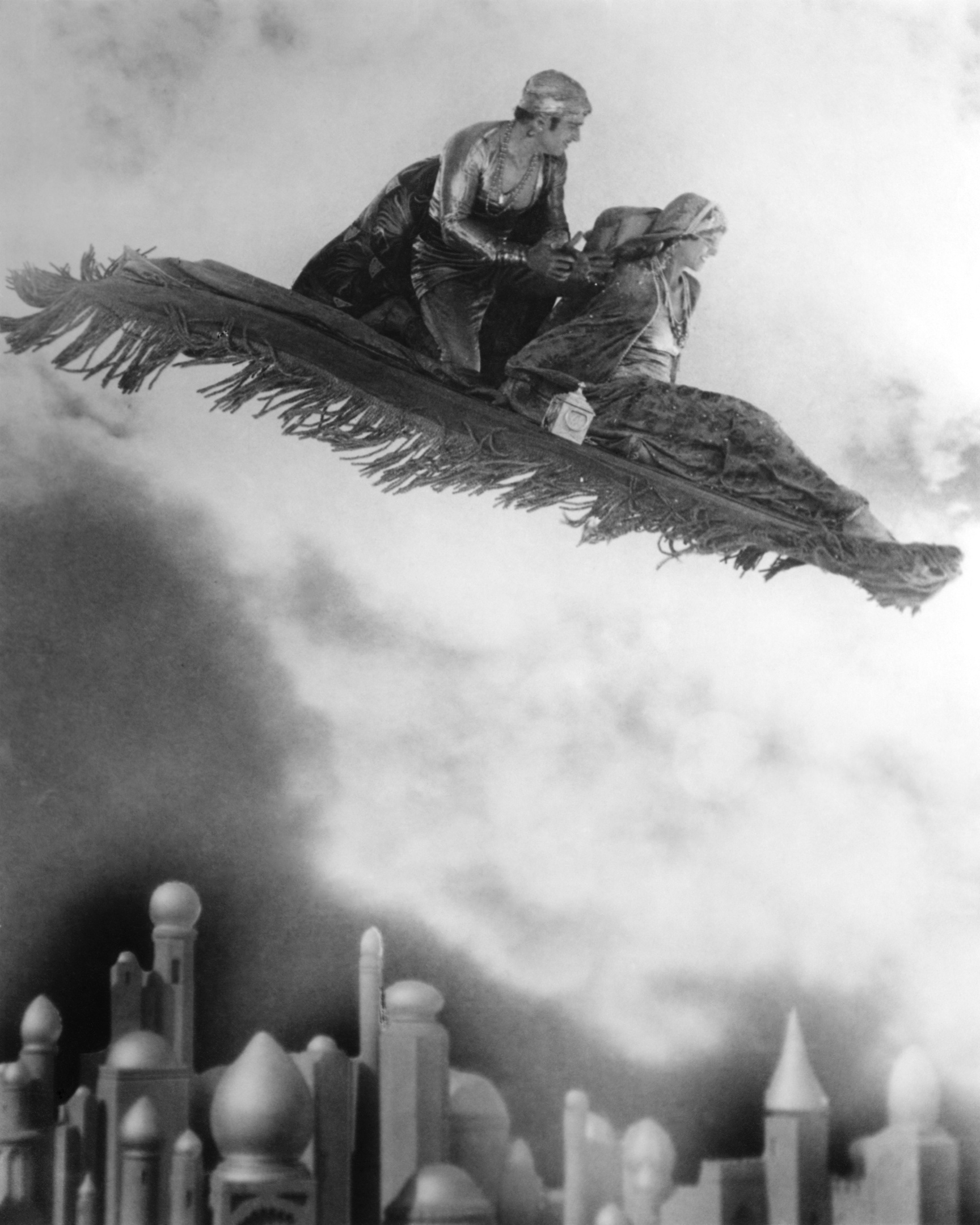
Music for the Silent Film Series
Fifty years? Was it only fifty years ago that Toronto Film Society began? For someone like me who was born before the Titanic sank (albeit by only two weeks), fifty years ago seems almost like yesterday. (If I tell people that I can still remember the new of the Titanic disaster being on the front page of the Globe and Mail, and my daddy reading it out loud to my mom and me, nobody ever seems to believe me–I don’t know why).
So perhaps nobody will believe me when I say I remember when Toronto Film Society was born–and they’ll be partially correct, for my memory can’t pin a date to it. (After all, the story was not on the front page of the Globe and Mail!) I was living in Toronto when the Titanic sank, and I was living in Toronto when TFS was formed, but in the years between I lived in Edmonton – that much I can remember. And obviously, if TFS is fifty years old in 1998, it must have been born in 1948.
I certainly remember TFS’s beginning – even though I didn’t become a member that first year. The very first president of the first Board of Directors of this newly-formed film society – Gerald Pratley – was a fellow writer in the CBC office where I was working, and so I was well aware of what was happening. And having been a movie buff since the days when I wasn’t much more than two weeks old, I was naturally very interested–and the only reason why I didn’t join up in that first year was that by the time the new film society announced its season, I had already subscribed for something else which was on the very same evenings. (What it was I have long since forgotten.)
But I most certainly made a point of joining Toronto Film Society for its second season and I’ve been a member ever since – and still am, for even though I moved back to Edmonton nearly three years ago, my Life Membership was never revoked. (Or if it was, nobody remembered to tell me). Unfortunately, being so far away, I can no longer access the films in TFS headquarters to help prod my memory. So I’ll assume that other contributors will be supplying the statistical details of those early days.
Several other film societies followed TFS in Toronto in those post-war years. Television had not yet come around the corner. One I seem to recall was called the Caligari Film Society. Another was run by students at the University of Toronto. And, several years later, there was the A-G-E, run by Aldo Maggiorotti, Gerald Pratley and Elwood Glover. And others. But they were never rivals. The people who ran one film society went to see the films the others were showing. And we were all good friends.
I gradually became acquainted with the individuals who ran the TFS in those early years. I already knew Bev and Doris Robinson, who were Board members either from the beginning or else shortly afterwards–and I soon got to know Oscar and Dorothy Burritt, who had recently arrived from Vancouver where they had been instrumental in founding the Vancouver Film Society. They later became neighbours of mine and also very close friends (both literally and figuratively).
There was also George Patterson, who came from Winnipeg; Philip and Ruth Budd; Douglas Wilson; and others. But my closer acquaintance with all of them began after Dorothy Burritt, some time in the mid-1950s, phoned me to ask if I would care to become a member of TFS Board of Directors. The next Annual General Meeting was coming up and a couple of the board members (probably the Robinsons) had decided not to run for re-election. The practice of the Board in those days was (and probably still is) to present a slate of nominees at the AGM, ask for other nominees from the floor, and if none came (and they seldom did) the slate got in by acclamation, as I did.
I can’t recall when TFS first expanded into a second series, under the direction of George Patterson, devoted to silent films (mostly European, it seems). Having grown up in the pre-talkies era, I naturally joined this series too, which for the first year or two held its screenings in one of the buildings on the University of Toronto campus before moving into the Unitarian Church on St Clair Avenue West, where it remained for many years.
For the first two or three years these silent films were very silent indeed, the only sound being the whirring of the projector. The original series–now being referred to as the Main Series–had occasionally presented silent films, for which a committee headed by Dorothy Burritt prepared a musical accompaniment from recordings (which in those days were still mostly 78s), which they then played (mostly too loud for my tastes) on two record players (so that they could cut quickly from one record to another as required). I occasionally was invited to be on the committee that tried to select the appropriate music.
Eventually George felt that the Silent Series should be using music, and I was asked to be on the committee. But I had a plan of my own. I had recently acquired a tape recorder, and I had the bright idea that the chosen music need not be played “live” on record players but could be recorded on tape so that the operator could push the button, and then sit back, fold his arms and enjoy the movie. So they accepted this proposal – along with my insistence that I alone choose and prepare the music. (I knew I could concentrate much better if I weren’t surrounded by other people).
And thus – on October 6, 1958, with Douglas Fairbanks in The Gaucho – began my twenty-year career of preparing taped music to accompany silent films, mostly for the Silent Series but also some that were shown in the Main Series. It was a task I learned the hard way: on the job, by trial and error; and I think I became pretty good at it.
Of course, it did help that my day job was part of the CBC’s Music Department, which meant that I had their vast Record Library at my disposal; and also that my job involved editing tape – although that part didn’t begin till long after I started doing it for TFS. And thanks to the aforementioned Oscar Burritt, whose day job was in the Film Department of CBC Television, I even prepared scores for a couple of silent films shown in his 1968 series Cinema Six (one of which, The Birth of a Nation, was based on a score I had prepared for the Silent Series showing, and I can’t resist adding that it eventually came out on video under the Republic Pictures label. My 15 minutes of fame!).
In the meantime, in 1963, George Patterson, being satisfied that he had shown all the silent films he had been anxious to see, decided to give up the Series; so at my request they turned it over to me. With the help of two other Board members, Helen Cowan and Ed Jull, the 1963-64 season consisted of films we wanted to see (such as Theda Bara in A Fool There Was, Rudolph Valentino in Blood and Sand, Douglas Fairbanks in The Thief of Bagdad, et al) and, much to our pleasant surprise, so did our prospective members; and for the next two or three season it was the Silent Series that supported the Main Series instead of the other way round.
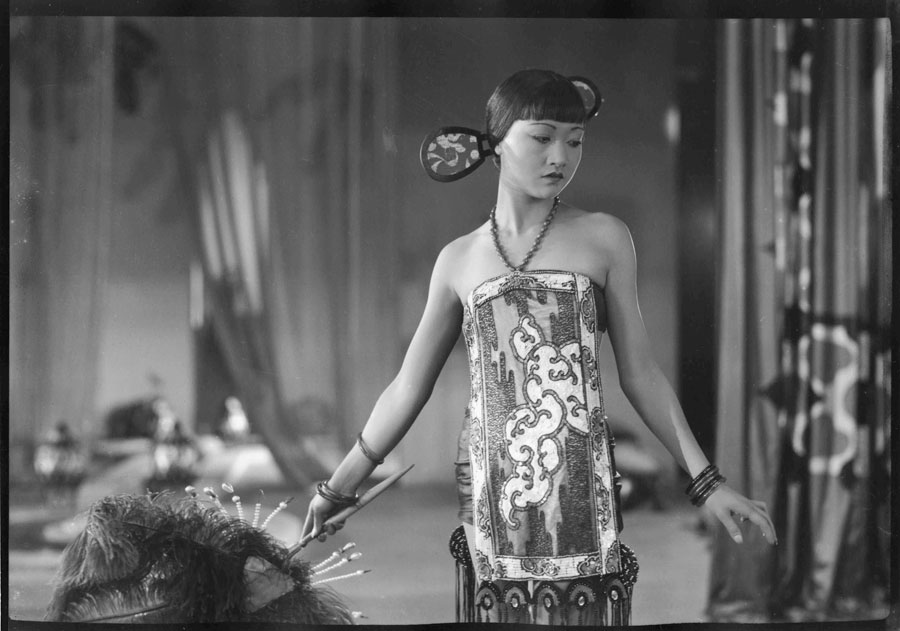
Unfortunately, taking over the job as head of the Silent Series also meant having to write the program notes. This it turned out that during the two weeks prior to each of the six shows per season my spare time was taken up with getting ready. The first week I spent writing and eventually typing the stencils for the mimeograph – and as I’m always long-winded (as you must have noted by now) this took a lot of time. Fortunately for me, somebody else operated the mimeograph machine. The film itself usually arrived from the Museum of Modern Art in New York via Ottawa, fairly early the following week, and I spent the rest of my “free” time choosing the music and recording it to tape – which sometimes obliged me to stay up all Sunday night to get it ready for the Monday night screening. (Fortunately for me my day job, in return for having to work Saturdays, gave me Mondays off!).
So no wonder that at the end of the 1967-67 season I at last bowed out, and the Silent Series was turned over to Board member Ed Jull (who had always operated the 16mm projector for the series). But I still continued to do the music scores until the end of the 1979-80 season.
So was it worth all that time and hard work? Of course it was. It was a lot of work, but I loved it! And on top of that, Ed and I, later joined by Oscar Burritt, and a few years later by Doug Wilson, instead of going home immediately after the show, got into the habit of going somewhere for a beer and pizza (or whatever), and that was fun–even after the occasions when I had been up for 36 hours. These were among the happiest days of my life.
I didn’t mean to get started on writing my autobiography – (“Sit down and I will tell you the story of my life…”). And I know, I know; one shouldn’t live in the past. But as I always say, what’s the good of having a past if you can’t at least drop in for a visit now and then? I’ve enjoyed this visit, and I hope that at least some of you did too.
Originally written for the 50th anniversary of the Toronto Film Society by Fraser Macdonald

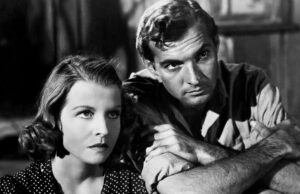
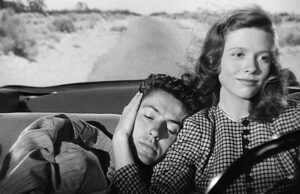
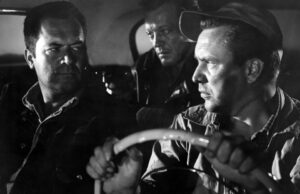






Leave a Reply